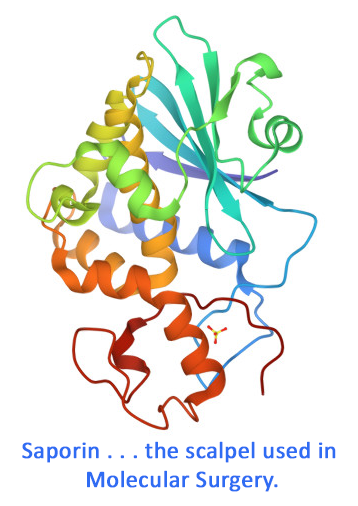Anti-DBH-SAP is a highly specific noradrenergic lesioning agent. It specifically targets cells that express DBH. This vesicular enzyme is exposed to the exterior milieu upon release of noradrenaline and thus allows these cells to be targeted with saporin. The specificity of Anti-DBH-SAP correlates well with uptake of the antibody when injected intraventricularly. After systemic administration, animals have a massive reduction in plasma norepinephrine levels, indicating efficient targeting and sympathectomy. Unlike other lesioning methods, this molecular lesioning agent assures definitive ablation of the target neurons expressing rat DBH. Permanent and selective removal of cerebral noradrenergic innervation makes an important animal model for the study of drug effects (anti-hypertensives, opiates, stimulants, etc.), behavior (fear, depression, food intake), plasticity of other systems in response to loss, and primary autonomic failure.
Anti-DBH-SAP is a chemical conjugate of the mouse monoclonal antibody to dopamine beta-hydroxylase and the ribosome-inactivating protein, saporin. It specifically eliminates cells that express dopamine beta-hydroxylase.
Anti-DBH-SAP is available individually (Cat. #IT-03) or as a kit (Cat. #KIT-03) which includes Anti-DBH-SAP and Mouse IgG-SAP (Cat. #IT-18).
keywords: Anti-DBH, DBH, Anti-dopamine beta-hydroxylase, dopamine ß-hydroxylase, DSAP, betanoradrenergic lesioning, removal of cerebral noradrenergic innervation, drug, behavior, plasticity, Locus coeruleus, subcoeruleus, Alzheimer’s disease, brain, neuroscience
Towards astroglia-based noradrenergic hypothesis of Alzheimer’s disease
Leanza G, Zorec R (2023) Towards astroglia-based noradrenergic hypothesis of Alzheimer's disease. Function (Oxf) 4(1):zqac060., IT. doi: 10.1093/function/zqac060 PMID: 36590326
Summary: These results indicate a prominent role of NA-neurons vs. ACh neurons in impairments of working memory, relevant for AD, and are consistent with an astrocyte-specific metabolic impairment in a mouse model of intellectual disability.
Usage: Bilateral icv injection of 192-IgG-SAP and/or Anti-DBH-SAP
Related Products: 192-IgG-SAP (Cat. #IT-01), Anti-DBH-SAP (Cat. #IT-03)
Pain and depression comorbidity causes asymmetric plasticity in the locus coeruleus neurons
Llorca-Torralba M, Camarena-Delgado C, Suárez-Pereira I, Bravo L, Mariscal P, Garcia-Partida JA, López-Martín C, Wei H, Pertovaara A, Mico JA, Berrocoso E (2022) Pain and depression comorbidity causes asymmetric plasticity in the locus coeruleus neurons. Brain 145(1):154-167. doi: 10.1093/brain/awab239
Summary: There is strong comorbidity between chronic pain and depression. This study explores how this comorbidity occurs. The authors refer to published research that shows icv administration of anti-DBH-SAP or intra-LC administration of lidocaine dampened the evoked pain in conditions of long-term nerve-injury. However, icv injection of anti-DBH-SAP disrupts all noradrenergic nuclei (A1-A7), some of which contribute to sensorial hypersensitivity.
Related Products: Anti-DBH-SAP (Cat. #IT-03)
See Also:
browse all references for this product | back to top


Reviews
There are no reviews yet.